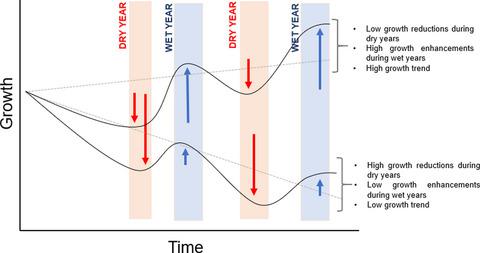Our official English website, www.x-mol.net, welcomes your feedback! (Note: you will need to create a separate account there.)
Impacts of recurrent dry and wet years alter long‐term tree growth trajectories
Journal of Ecology ( IF 5.5 ) Pub Date : 2020-12-22 , DOI: 10.1111/1365-2745.13579 Xavier Serra‐Maluquer 1 , Elena Granda 1, 2 , Jesús J. Camarero 1 , Albert Vilà‐Cabrera 3, 4 , Alistair S. Jump 4 , Raúl Sánchez‐Salguero 5 , Gabriel Sangüesa‐Barreda 6 , Juan B. Imbert 7 , Antonio Gazol 1
中文翻译:

反复的干旱和潮湿年份的影响改变了树木的长期生长轨迹
更新日期:2020-12-22
Journal of Ecology ( IF 5.5 ) Pub Date : 2020-12-22 , DOI: 10.1111/1365-2745.13579 Xavier Serra‐Maluquer 1 , Elena Granda 1, 2 , Jesús J. Camarero 1 , Albert Vilà‐Cabrera 3, 4 , Alistair S. Jump 4 , Raúl Sánchez‐Salguero 5 , Gabriel Sangüesa‐Barreda 6 , Juan B. Imbert 7 , Antonio Gazol 1
Affiliation

|
- Climate extremes, such as abnormally dry and wet conditions, generate abrupt shifts in tree growth, a situation which is expected to increase under predicted climate conditions. Thus, it is crucial to understand factors determining short‐ and long‐term tree performance in response to higher frequency and intensity of climate extremes.
- We evaluated how three successive droughts and wet years influenced short‐ and long‐term growth of six dominant Iberian tree species. Within species variation in growth response to repeated dry and wet years was evaluated as a function of individual traits related to resource and water use (diameter at breast height [DBH], wood density [WD] and specific leaf area [SLA]) and tree‐to‐tree competition across climatically contrasted populations. Furthermore, we assessed how short‐term accumulated impacts of the repeated dry and wet years influenced long‐term growth performance.
- All species showed strong short‐term growth decreases and enhancements due to repeated dry and wet years. However, patterns of accumulated growth decreases (AcGD) and enhancements (AcGE) across climatically contrasting populations were species‐specific. Furthermore, individual trait data were weakly associated with either AcGD or AcGE and the few relevant associations were found for conifers. Intraspecific variations in tree growth responses to repeated climates extremes were large, and not explained by intraspecific variability in SLA and WD. Accumulated impacts of repeated dry and wet years were related to long‐term growth trends, showing how the recurrence of climate extremes can determine growth trajectories. The relationships of AcGD and AcGE with long‐term growth trends were more common in conifers species.
- Synthesis. Repeated climate extremes do not only cause short‐term growth reductions and enhancements but also determine long‐term tree growth trajectories. This result shows how repeated droughts can lead to growth decline. Conifers were more susceptible to the accumulated effects of extreme weather events indicating that in the future, more intense and frequent climate extremes will alter growth performance in forests dominated by these species.
中文翻译:

反复的干旱和潮湿年份的影响改变了树木的长期生长轨迹
- 极端的气候条件(例如异常干燥和潮湿的条件)会导致树木生长突然发生变化,这种情况在预计的气候条件下有望增加。因此,至关重要的是要了解决定短期和长期树木性能的因素,以响应极端气候的较高频率和强度。
- 我们评估了连续三天的干旱和潮湿年份如何影响六种主要伊比利亚树种的短期和长期生长。在物种内部,对反复干旱和潮湿年份的生长响应的变化被评估为与资源和水分利用(胸高直径[DBH],木材密度[WD]和比叶面积[SLA])有关的各个性状的函数气候差异人群之间的树到树竞争。此外,我们评估了反复干旱和潮湿年份的短期累积影响如何影响长期增长表现。
- 由于反复的干旱和潮湿年份,所有物种都显示出强劲的短期生长下降和增强。但是,在气候不同的种群中,累积生长减少(AcGD)和增加(AcGE)的模式是特定于物种的。此外,个体性状数据与AcGD或AcGE的关联较弱,并且针叶树的相关性很少。树木生长对反复出现的极端气候的响应中的种内差异很大,而SLA和WD的种内变异性无法解释。反复的干旱和潮湿年份的累积影响与长期增长趋势有关,显示了极端气候的复发如何确定增长轨迹。在针叶树种中,AcGD和AcGE与长期生长趋势之间的关系更为普遍。
- 综合。反复出现的极端气候不仅会导致短期生长减少和增强,而且还会确定长期树木的生长轨迹。这一结果表明,反复干旱会导致增长下降。针叶树更容易受到极端天气事件的累积影响,这表明,未来,更强烈,更频繁的气候极端事件将改变以这些物种为主的森林的生长性能。



























 京公网安备 11010802027423号
京公网安备 11010802027423号